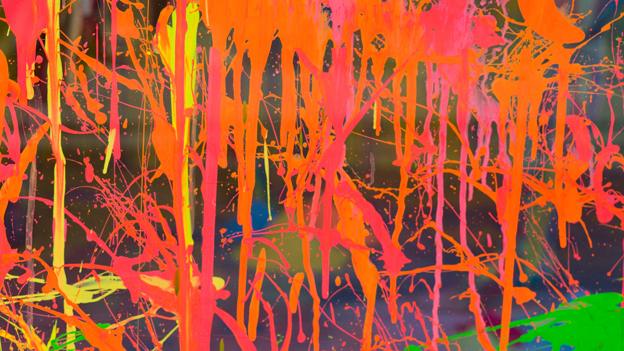Missy Douglas: Visualising bipolar disorder through art
- Published

Day 177. "I was really in a dark place here. I was completely in a depressive phase."
Fed up with keeping her mental health a secret, bipolar disorder sufferer Missy Douglas spent a year creating a painting each day to express her feelings. Controversially, she decided not to take her medication during this time, in the hope that paintings demonstrating her highs and lows would raise awareness of her condition.
Waking up each morning, Missy Douglas has no idea how the day will go. She may feel invincible, or she may be hit by a bout of depression.
Battling the emotional extremes in life has become second nature to the 37-year-old artist, who has lived with bipolar disorder, external for most of her adult life.
Last year she chose to do what she does best. Every day, for a year, she picked up her paintbrushes and painted exactly how she felt.
She decided to give up her medication while she carried out the project.
"I wanted it to be as pure a view of the disorder as possible," she said.

Day 236. "I was burying feelings and my emotions were all over the place. Very turbulent."
"Painting every day didn't make me feel more stable or increase my sense of wellbeing," said Douglas. "In fact, trying to look inside and express raw emotion or psychological distress everyday was very difficult.
"It sometimes exacerbated the depression or mania I was experiencing at the time. However, when I look back I can recognise the patterns and rhythms of my own 'brand' of the disorder."

Day 242. "I was at the height of mania here, but there was a massive wave of white depression heading towards me."
Bipolar disorder brings about strong mood swings that can last for several weeks.
It can leave people unable to form relationships or cope with the day-to-day routine of work and - in extreme circumstances - lead to a feeling of worthlessness.
Douglas, who is originally from Northampton but now lives in New York, said living with the condition could be "extremely exhausting".

Bipolar disorder
• Formerly known as manic depression, it is a condition that affects moods, which can swing from depression to mania
• Symptoms range from overwhelming feelings of worthlessness to feeling very happy and having lots of ambitious plans and ideas
• Each extreme episode can last several weeks
• Treatment includes mood stabilisers which are to be taken every day on a long-term basis, combined with talking therapy and lifestyle changes
Source: NHS

"This is something you don't always appreciate, as you are constantly living in the eye of the bipolar storm," said the artist, who is now taking her medication again.
She was first diagnosed as bipolar aged 19, when she was studying art history at the University of Cambridge. She said it finally joined the dots as to why she often felt withdrawn and melancholic, or precocious and arrogant.

Day 314 – Mania. "I was buzzing and everything was technicolor and beautiful. I was flying and felt invincible."
"My mania is characterised by buzzing limbs, insomnia, working frenetically, moving constantly but never tiring," she said.
"I also feel incredibly positive, almost arrogant, like I am better than everyone else and that I can achieve anything. Depression is like a numb white cloud. You can barely see or hear.
"I am pretty much agoraphobic, I shut myself away and do not communicate. I've attempted suicide and have been sectioned, which was the lowest I've ever been."

Day 359 - Christmas Day 2013. "I was feeling very depressed yet I completely compartmentalised and concealed it. The twinkly forced jollity hid the sadness."
However, despite the intense lows she has experienced, the condition has not stopped her from achieving her dreams.
In 2009 she left the UK and established her own fine art studio and art school in Brussels. Two years later she headed to New York and now spends her time immersed in the creative scenes of Long Island, Queens and further afield in Seattle.
Her latest project, collecting the daily paintings for her new book, 2:365, external, aims to tackle her condition head on.
"Initially the main reason for doing the project was very personal," she said.
"I had kept my diagnosis a secret for 17 years. I had pretended and performed within an inch of my life, which had taken its toll and concealed who I really was."

Missy Douglas now lives in New York
She added: "I knew the time was right to finally come clean and acknowledge publicly who I was.
"I was petrified as I thought that people would assume that I was being melodramatic, self-absorbed or even lying. It was easier coming out through my work. It made me feel comfortable."
Douglas said she hoped the paintings would help break down the stigma surrounding mental health and help sufferers realise they are not alone.

Day 5. "I was really anxious, angry and feeling trapped."
"I suddenly realised it could have a big social impact and go some way to raising the profile of mental health," she said.
"Since seeing the paintings, people have thanked me and opened up to me about their own experiences. Having the courage to say, 'I have bipolar disorder' is so valuable, as it can empower others to do the same.
"We probably know people who have it but we are completely unaware of their private battle.
"And, more often than not, they are interesting, talented and successful people with just as much to give as everyone else."
- Published12 August 2014

- Published22 July 2014

- Published22 July 2014

- Published13 July 2014

- Published20 June 2014

- Published23 May 2014

- Published13 May 2014
